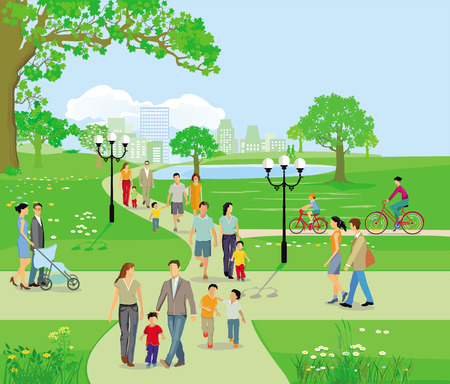Introduction: The Importance of Green Spaces in London
London is celebrated for its vibrant energy, historic landmarks, and diverse communities, but at its heart lies a surprising abundance of green spaces. These parks, commons, and gardens are more than just patches of grass—they are vital lungs for the city, offering essential respite from the urban rush. For Londoners, especially families, access to these green havens is crucial for well-being, relaxation, and connection with nature. Accessible walks within these spaces provide inclusive opportunities for families to explore together, regardless of age or mobility needs. Whether it’s strolling along tree-lined paths in Hyde Park or discovering wildlife in Richmond Park, accessible walks help foster healthier lifestyles and cherished memories. In a city as bustling as London, these green escapes remind us that nature is never far away, enriching daily life for locals and visitors alike.
2. Iconic Parks: Family-Friendly Walks in Central London
Central London is home to some of the world’s most celebrated parks, offering a refreshing escape from the city’s urban hustle. For families, these green spaces aren’t just beautiful—they’re also thoughtfully designed with accessibility in mind. Two of the most renowned are Hyde Park and Regent’s Park, both featuring wide, well-maintained paths perfect for prams, pushchairs, and energetic little legs.
Hyde Park: A Classic Stroll
Hyde Park stands out as a must-visit for families seeking a day out in nature without leaving the heart of London. The park’s broad walkways are mostly flat, making them ideal for families with young children or those using wheelchairs. Highlights include the Serpentine Lake, Diana Memorial Fountain (with splash-friendly zones), and ample playgrounds dotted throughout. There are plenty of benches for rest stops and accessible toilets conveniently located near main entrances.
Recommended Hyde Park Walking Route
| Start Point | Key Stops | Distance | Facilities |
|---|---|---|---|
| Marble Arch Gate | Speaker’s Corner – Serpentine Lake – Diana Memorial Playground | Approx. 2 miles (3.2 km) | Cafés, accessible toilets, picnic spots |
Regent’s Park: Gardens and Wildlife
Regent’s Park is another family favourite, especially known for its beautifully kept gardens and open spaces. The park features smooth tarmac paths suitable for prams and wheelchairs. The Boating Lake and Queen Mary’s Gardens provide picturesque backdrops for easy strolls, while the extensive playground near Hanover Gate is perfect for a mid-walk play session. Families can also spot ducks and other wildlife along the way.
Recommended Regent’s Park Walking Route
| Start Point | Key Stops | Distance | Facilities |
|---|---|---|---|
| Baker Street Gate | Queen Mary’s Gardens – Boating Lake – Hanover Gate Playground | Approx. 1.5 miles (2.4 km) | Cafés, accessible toilets, picnic areas |
Top Tips for Family Walks in Central Parks
- Avoid peak times if possible—early mornings or late afternoons tend to be quieter.
- Packed lunches are welcome in most park areas; look out for designated picnic lawns.
- If visiting with toddlers or young children, keep an eye out for water features and open ponds.
Exploring Hyde Park and Regent’s Park offers a brilliant introduction to London’s accessible green spaces. With carefully maintained routes and thoughtful amenities, these central parks ensure that every member of the family can enjoy the capital’s natural beauty together.

3. Hidden Gems: Lesser-Known Greenspace Strolls
While London’s celebrated parks like Hyde Park and Regent’s Park draw the crowds, families seeking a more tranquil experience will find a wealth of hidden gems dotted across the city. These smaller, often-overlooked greenspaces are ideal for peaceful strolls, offering both accessibility and a welcome respite from urban bustle.
Discovering Peaceful Alternatives
One such gem is Brockwell Park in Herne Hill. Though well-loved by locals, it remains under the radar for many visitors. Its gentle paths wind through mature trees, ponds, and wildflower meadows – perfect for pushchairs and little explorers alike. The park also boasts charming walled gardens and sweeping city views.
Nature Reserves with a Family Focus
If you fancy venturing even further off the beaten path, consider Coombe Wood in Croydon or Camley Street Natural Park near King’s Cross. These managed reserves are havens for wildlife and offer accessible trails suitable for prams and wheelchairs. Children can spot birds, insects, and wildflowers while parents appreciate the quietude away from busy streets.
Pocket Parks Across the Capital
Lesser-known spaces like Postman’s Park in the heart of the City or Myatt’s Fields Park in Camberwell provide compact but beautifully maintained settings for family walks. Many feature play areas or community-run cafés—ideal for a cup of tea while little ones let off steam.
For families looking to slow down and soak up some greenery without jostling with crowds, these hidden corners of London offer a delightful alternative to the city’s larger parks, ensuring every walk is both accessible and memorable.
Accessibility and Facilities for Families
When planning a family outing in London’s green spaces, accessibility is often at the top of the list for parents and carers. Fortunately, many of the capital’s parks and gardens have invested in features that make walks easy and enjoyable for everyone, regardless of age or mobility needs. Below, we discuss some of the most family-friendly facilities commonly found across London’s parks.
Step-Free Paths and Buggy-Friendly Routes
One of the key considerations for families with young children or those with mobility challenges is the availability of step-free paths. Parks like Hyde Park, Greenwich Park, and Regent’s Park offer well-maintained, wide tarmac paths that are perfect for prams, wheelchairs, and scooters alike. This makes it easy to navigate without worrying about stairs or uneven terrain.
Play Areas and Child-Friendly Stops
Many of London’s parks feature thoughtfully designed play areas, catering to different age groups and interests. These spaces provide a safe environment for children to burn off energy while adults enjoy a moment’s rest. Look out for inclusive play equipment that accommodates children of all abilities.
Convenient Facilities: Loos and Café Stops
Nothing derails a family walk faster than the lack of nearby toilets or somewhere to grab a snack. Thankfully, most major parks offer clean toilet facilities—often including accessible loos—and baby-changing stations. Many also boast cafés serving everything from hot drinks to healthy lunches.
Family-Friendly Features at a Glance
| Park | Step-Free Paths | Play Area | Buggy Friendly | Loos Available | Café On Site |
|---|---|---|---|---|---|
| Hyde Park | Yes | Yes | Yes | Yes | Yes |
| Greenwich Park | Yes (main routes) | Yes | Yes | Yes | Yes |
| Battersea Park | Yes | Yes (large adventure playground) | Yes | Yes | Yes (multiple) |
Tips for Visiting with Family
– Check park websites for up-to-date information on accessible routes.
– Bring a picnic or use on-site cafés for refreshments.
– Arrive early during weekends or school holidays to avoid crowds at popular play areas.
– Take advantage of dedicated family events often held in these green spaces.
5. Seasonal Tips and What to Bring
Exploring London’s green spaces with your family is a year-round treat, but it pays to be prepared for the city’s famously changeable weather. Each season offers its own charm, from springtime blooms in Regent’s Park to autumn’s golden leaves in Richmond Park. Here are some practical tips to make the most of your walks whatever the weather.
Dressing for the Weather
The British weather can turn on a sixpence, so layers are your best friend. In spring and summer, lightweight rain jackets and hats are advisable, as showers can pop up unannounced. Come autumn and winter, opt for waterproof boots and warm, windproof coats. Always bring an extra jumper or two for little ones, especially if you plan to stay out until dusk.
Essentials for Every Family Outing
- Packed water bottles – staying hydrated is key, even on cooler days.
- Healthy snacks or a picnic hamper – many parks have scenic spots like Primrose Hill or Hyde Park’s Serpentine where you can lay out a blanket.
- A foldable blanket or mat – perfect for impromptu picnics or rest stops.
- Reusable bags for any litter – help keep London’s parks pristine for everyone.
- Sunscreen and insect repellent during warmer months.
- Binoculars or a magnifying glass for nature spotting – children love looking out for birds, squirrels, and insects.
Finding the Best Picnic Spots
Some of London’s parks have designated picnic areas with benches and tables, such as Hampstead Heath’s Parliament Hill or the tranquil Isabella Plantation in Richmond Park. For quieter escapes, head to lesser-known corners of Wimbledon Common or Epping Forest. Remember that barbecues are not permitted in most public parks, so stick to sandwiches, salads, and finger food.
Planning Ahead
Check the Met Office forecast before heading out, and look up park facilities in advance – many have accessible toilets, baby changing stations, and cafés if you need a warm drink. Lastly, keep an eye on park opening times as these can vary throughout the year. With a bit of preparation, every stroll through London’s green spaces can become a memorable adventure for the whole family.
6. Encouraging a Greener Future
Supporting and nurturing London’s green spaces goes beyond simply enjoying a walk; it is about actively contributing to their preservation for future generations. Families can play a vital role in this by getting involved in local initiatives, volunteering, or even starting small projects within their community. Many parks and commons across the capital offer regular volunteering opportunities—ranging from litter-picking sessions to planting wildflowers or assisting with habitat restoration. These activities not only help maintain the natural beauty of these areas but also foster a sense of ownership and pride among residents.
Getting Involved Locally
Local Friends groups, often organised through councils or community networks, are a fantastic entry point for families keen to support their neighbourhood green spaces. By joining these groups, families can participate in seasonal events, conservation days, and educational workshops that engage children and adults alike. This hands-on involvement helps young people understand the importance of environmental stewardship while making meaningful contributions close to home.
Educational Initiatives and Community Projects
Many green spaces work closely with schools and youth organisations to run nature clubs, outdoor classrooms, and wildlife surveys. If your local park does not currently offer such programmes, consider collaborating with other parents or teachers to propose new initiatives. Even small-scale projects, like creating a bug hotel or organising a birdwatching morning, can spark interest in sustainability and biodiversity.
Supporting Sustainable Practices
Beyond volunteering time, families can advocate for greener practices by supporting local campaigns focused on reducing single-use plastics during park visits or encouraging responsible dog-walking. Fundraising efforts for new benches, accessible pathways, or play equipment benefit everyone and demonstrate a collective commitment to inclusivity in public spaces.
Together, these actions help ensure that London’s green spaces remain vibrant, accessible sanctuaries where communities thrive—both now and in the future. By taking proactive steps today, families become custodians of the capital’s natural heritage, inspiring others to cherish and protect these much-loved urban oases.


